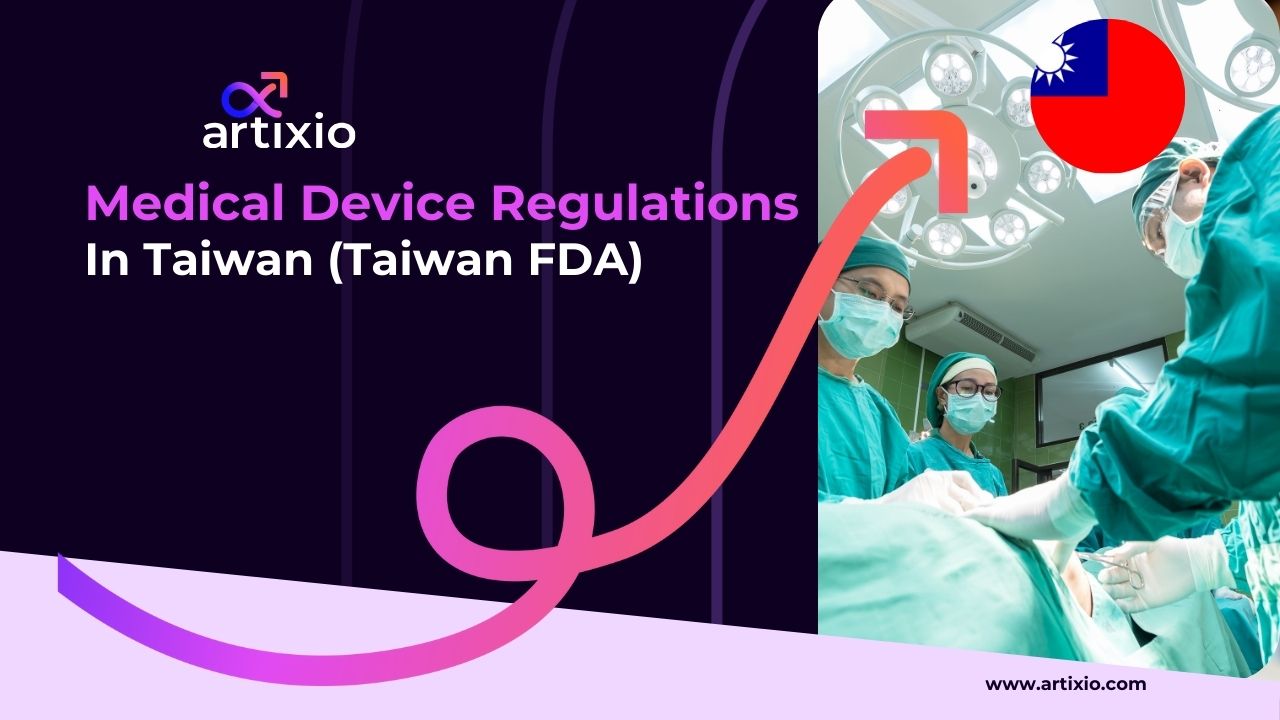Medical devices regulations and registration process in Taiwan explained
- The market value of the medical device industry in Taiwan is estimated worth $3.5 billion USD and is expected to grow at a compound annual growth rate (CAGR) of 5% by 2026.
- Taiwan and the United States share a bilateral trade relationship that is promoted and facilitated by the ‘regulatory harmonization’ between the two countries. While the United States is one of the largest export destinations for Taiwanese medical devices valued at $2.5 billion, Taiwan imports medical devices from the U.S. market which was valued at $1.2 billion in the year 2020.
- More than 1/4th of the import belongs to European Union while other major suppliers include Japan and China.
Medical Device Regulatory Authority in Taiwan
Taiwan Food and Drug Administration (TFDA) under the Ministry of Health and Welfare (MOHW) regulates all medical devices. The Pharmaceutical Affairs Act (PAA) provides the legislative framework for ensuring the safety, efficacy, quality, and intended use of medical devices.
Classification of Medical Devices
Taiwan follows the International Medical Device Classification System (IMDRF) for classifying medical devices which is based on the risk level, intended use, duration of the contact with human body, and invasiveness.
Class I non-invasive medical devices carry low risk and possess low potential hazards such as thermometers, forceps, and surgical instruments. General labeling for Class I devices is required clearly specifies information on:
- Product name
- Manufacturer’s name and address
- Device specifications and model number
- Intended use or indications for use
- Date of manufacture or expiration date (if applicable)
- Storage conditions (if applicable)
- Instructions for use and any necessary precautions or warnings
- Labeling should be in Chinese.
Class II medical devices carry moderate risk and are those that are either invasive or non-invasive. Examples: Endoscopes, ECG machines, and dental instruments.
Class III invasive medical devices carry high risk and hence are subjected to stringent regulatory processes before providing marketing authorization. Examples: Implantable pacemakers, defibrillators, artificial heart valves
Class IV or Invitro diagnostic (IVD) devices such as molecular testing devices – NGS, PCR
For Class II, Class III, and IVD medical devices, general labeling requirements include:
- Product specifications, including technical parameters and performance characteristics
- Detailed instructions for use and any necessary precautions or warnings
- Identification of the product as a medical device
- Usage limitations and contraindications
- Batch or lot number
- Above requirements are essential in addition to all the information that is required for Class I devices
- Additional Requirements are applicable to certain devices such as specific warnings, biohazard symbols, pictograms, electrical safety symbols, or radiation warning signs
- The labeling must be in Chinese. For Class III and Class IV devices, it is required to include the Chinese translation of the international non-proprietary name (INN) of the active ingredient(s) on the label.
- For all classes, the use of English and other languages is allowed
- Updates on UDI labeling requirements
TFDA implemented UDI labeling requirements for certain medical devices based on the risk level and their intended use. A recent update states that labeling is not applicable to all classes of medical devices and commenced labeling for newly manufactured Medical and Diagnostic Devices.
- Labeling of Class III high-risk category medical devices, such as implantable devices and non-implantable devices commenced in June 2021 and June 2022, respectively.
- Class II, moderate-risk medical devices require UDI labeling /reporting commenced in June 2023.
Clinical trial requirements:
- Before a device enters clinical trial, Ethics Committee Approval is needed to carry out clinical trials with appropriate patient care measures and informed consent.
- An Investigation Device Exemption (IDE) application including details of the device, trial protocol, patient recruitment criteria, and study endpoints must be submitted to the TFDA for approval before initiating clinical trials.
- Good Clinical Practice (GCP) guidelines for data management which ensure proper record maintenance, informed consent documentation, adverse event reporting, and trial monitoring must be followed while the clinical trial is ongoing. Periodic progress and results which includes any adverse events or safety concerns must be reported to the TFDA.
- TFDA recognizes product testing conducted by internationally recognized bodies, such as ISO 17025 accredited laboratories or laboratories accredited by other national accreditation bodies.
Products approved by the EU/US have a special advantage, devices that are approved in the EU or the US can be fast-tracked for approval in Taiwan since it can streamline the registration process and accelerate market access.
The Expedited Review process is simplified since TFDA accepts all the technical documents and clinical data that are submitted to the EU or US regulatory authorities.
Steps involved in the medical devices registration process by TFDA:
- Appointing Taiwanese representation
Manufacturers located outside Taiwan are required to appoint Taiwan regulatory representative, who shall be referred to as a Local responsible party (LRP).
- Pre-submission consultation
The manufacturer is expected to go through a free pre-submission consultation with TFDA to confirm the requirements before the regulatory process begins which happens in 2-4 weeks’ timelines.
- Document requirement
Preparation of various documents requires several weeks depending on the complexity of the device. There is no processing fee involved.
- Documents include:
- Technical files, including device description, specifications, and design documentation
- Labeling information, including labels, instructions for use, and packaging details
- Product testing and verification reports –
Pre-Market Approval: Typically, all medical devices require pre-market approval from the TFDA before they a device can enter the market. The type of approval required depends on the class of the device.
Performance Testing ensures functional and technical aspects of the device meet the intended standards and must undergo performance testing to assess their safety, functionality, and efficacy.
- Clinical data (if applicable), such as clinical study reports and evidence of safety and efficacy
- Quality management system (QMS) documentation, including manufacturing and quality control processes.
Application submission
LRP shall submit the application along with the necessary documents to the TFDA. Class II and III require the submission of a dossier including technical information, product test reports, and any necessary clinical data. Timelines span between 10-15 working days for Class I devices to 30-60 working days for Class II and III devices.
Review of application
TFDA conducts a thorough review process and evaluates the application along with all the additional technical documents. The TFDA takes about 90 working days for the review of Class I medical device applications and about 180 working days for Class II and III medical devices. The evaluation fees vary from ~500 USD for a class I device to ~3500 USD for a class III device.
Securing ‘Quality System Declaration (QSD) Certificate
TFDA conducts an inspection at the manufacturing facility for the quality management system implemented at the site to ensure they the GMP standards and issues QSD to certify that the manufacturer’s QMS meets the regulatory standards. It takes about 60 working days for class II and II devices and attracts a fee of approximately 2000 USD.
Granting of License
TFDA issues a license to the representative upon successful completion of the evaluation process. A fee of ~50 USD is applicable for issuing a copy of the certificate. Typically, the license is valid for a period of three to five years however, the duration of validity varies depending on the device.
Post Approval Change Management of Medical Devices
The TFDA shall review changes in procedures, approval criteria, or any other changes in medical devices post-approval before transfer, extension, renewal, and re-issuance of the license.
Pharmacovigilance requirements include monitoring and evaluating the safety and performance of medical devices in real-world use. TFDA expects timely reporting of adverse events and updates on the safety profile of medical devices on the market. Manufacturers and healthcare professionals are required to report adverse events, contributing to post-market surveillance efforts.
Variations and Modifications If there are any changes to the registered medical device, such as modifications in design, labeling, manufacturing process, or intended use, manufacturers shall submit variation applications to the TFDA. TFDA will review and assess the variations are compliant and ensure continued safety and efficacy.
Renewal of Product Registration: Typically, medical device registrations in Taiwan are valid for a period of five years. TFDA conducts periodic inspections, product sampling, and audits to monitor the safety and quality of medical devices available in the market. Manufacturers need to initiate the renewal process before the expiration date to maintain the market approval status. The renewal application involves submitting updated technical documentation, product information, and compliance with current regulations.
Audits and Inspections: TFDA conducts periodic inspections, product sampling, and audits to monitor the safety and quality of medical devices. These audits may focus on quality management systems, manufacturing practices, labeling and advertising, post-market surveillance, and other aspects of device safety and performance.
Field Safety Corrective Actions: If a medical device exhibits any potential risk to patient safety or does not meet regulatory requirements, the manufacturer may need to initiate a field safety corrective action to mitigate the risk and protect public health, such as product recall, device modification, or additional warnings and precautions.
For more information on the regulatory approval process, get in touch with Artixio and to learn more about the regulatory process in Taiwan.
References:
- https://www.mohw.gov.tw/mp-2.html
- https://www.fda.gov.tw/eng/
- https://english.doh.gov.taipei/
- https://www.ncbi.nlm.nih.gov/pmc/articles/PMC3960712/




